[1] FAN Q, CAVUS O, XIONG L, et al. Spinal Cord Injury: How Could Acupuncture Help? J Acupunct Meridian Stud. 2018;11(4):124-132.
[2] FENG H, XU H, ZHANG H, et al. Epidemiological profile of 338 traumatic spinal cord injury cases in Shandong province, China. Spinal Cord. 2022; 60(7):635-640.
[3] CHEN J, CHEN Z, ZHANG K, et al. Epidemiological features of traumatic spinal cord injury in Guangdong Province, China. J Spinal Cord Med. 2021; 44(2):276-281.
[4] KHADOUR FA, KHADOUR YA, MENG L, et al. Epidemiological features of traumatic spinal cord injury in Wuhan, China. J Orthop Surg Res. 2023;18(1):72.
[5] ANJUM A, YAZID MD, FAUZI DAUD M, et al. Spinal Cord Injury: Pathophysiology, Multimolecular Interactions, and Underlying Recovery Mechanisms. Int J Mol Sci. 2020;21(20):7533.
[6] SILVER J, MILLER JH. Regeneration beyond the glial scar. Nat Rev Neurosci. 2004;5(2):146-156.
[7] ORR MB, GENSEL JC. Spinal Cord Injury Scarring and Inflammation: Therapies Targeting Glial and Inflammatory Responses. Neurotherapeutics. 2018;15(3):541-553.
[8] LI X, LI M, TIAN L, et al. Reactive Astrogliosis: Implications in Spinal Cord Injury Progression and Therapy. Oxid Med Cell Longev. 2020;2020:9494352.
[9] LI C, WU Z, ZHOU L, et al. Temporal and spatial cellular and molecular pathological alterations with single-cell resolution in the adult spinal cord after injury. Signal Transduct Target Ther. 2022;7(1):65.
[10] ZHANG C, WANG MM, ZHANG Y, et al. Downregulation of miRNA-127-5p aggravates spinal cord injury through activating MAPK1. Eur Rev Med Pharmacol Sci. 2019;23(24):10617-10622.
[11] PINCHI E, FRATI A, CANTATORE S, et al. Acute Spinal Cord Injury: A Systematic Review Investigating miRNA Families Involved. Int J Mol Sci. 2019;20(8):1841.
[12] GUO XD, HE XG, YANG FG, et al. Research progress on the regulatory role of microRNAs in spinal cord injury. Regen Med. 2021;16(5):465-476.
[13] YU DS, LV G, MEI XF, et al. MiR-200c regulates ROS-induced apoptosis in murine BV-2 cells by targeting FAP-1. Spinal Cord. 2015;53(3):182-189.
[14] 朱琳,郭世武,刘锦波,等.miR-29a调控水通道蛋白4抑制过氧化氢诱导的星形胶质细胞凋亡[J].中国组织工程研究,2023,27(19):2993-2998.
[15] DONG J, XIA R, ZHANG Z, et al. lncRNA MEG3 aggravated neuropathic pain and astrocyte overaction through mediating miR-130a-5p/CXCL12/CXCR4 axis. Aging (Albany NY). 2021;13(19):23004-23019.
[16] KIERAN NW, SURESH R, DORION MF, et al. MicroRNA-210 regulates the metabolic and inflammatory status of primary human astrocytes. J Neuroinflammation. 2022;19(1):10.
[17] NAKANO M, KUBOTA K, KOBAYASHI E, et al. Bone marrow-derived mesenchymal stem cells improve cognitive impairment in an Alzheimer’s disease model by increasing the expression of microRNA-146a in hippocampus. Sci Rep. 2020;10(1):10772.
[18] JIANG D, GONG F, GE X, et al. Neuron-derived exosomes-transmitted miR-124-3p protect traumatically injured spinal cord by suppressing the activation of neurotoxic microglia and astrocytes. J Nanobiotechnology. 2020;18(1):105.
[19] FAN W, LIANG C, OU M, et al. MicroRNA-146a Is a Wide-Reaching Neuroinflammatory Regulator and Potential Treatment Target in Neurological Diseases. Front Mol Neurosci. 2020;13:90.
[20] JOVIČIĆ A, ROSHAN R, MOISOI N, et al. Comprehensive expression analyses of neural cell-type-specific miRNAs identify new determinants of the specification and maintenance of neuronal phenotypes. J Neurosci. 2013;33(12):5127-5137.
[21] SISON SL, PATITUCCI TN, SEMINARY ER, et al. Astrocyte-produced miR-146a as a mediator of motor neuron loss in spinal muscular atrophy. Hum Mol Genet. 2017;26(17):3409-3420.
[22] ZHANG H, WANG Y, LIAN L, et al. Glycine-Histidine-Lysine (GHK) Alleviates Astrocytes Injury of Intracerebral Hemorrhage via the Akt/miR-146a-3p/AQP4 Pathway. Front Neurosci. 2020;14:576389.
[23] JUNG HJ, SUH Y. Regulation of IGF -1 signaling by microRNAs. Front Genet. 2015;5:472.
[24] TALIFU Z, QIN C, XIN Z, et al. The Overexpression of Insulin-Like Growth Factor-1 and Neurotrophin-3 Promote Functional Recovery and Alleviate Spasticity After Spinal Cord Injury. Front Neurosci. 2022;16:863793.
[25] PAN S, QI Z, LI Q, et al. Graphene oxide-PLGA hybrid nanofibres for the local delivery of IGF-1 and BDNF in spinal cord repair. Artif Cells Nanomed Biotechnol. 2019;47(1):651-664.
[26] ZHANG D, YUAN Y, ZHU J, et al. Insulin-like growth factor 1 promotes neurological functional recovery after spinal cord injury through inhibition of autophagy via the PI3K/Akt/mTOR signaling pathway. Exp Ther Med. 2021;22(5):1265.
[27] ZHAO Z, ZHANG L, GUO XD, et al. Rosiglitazone Exerts an Anti-depressive Effect in Unpredictable Chronic Mild-Stress-Induced Depressive Mice by Maintaining Essential Neuron Autophagy and Inhibiting Excessive Astrocytic Apoptosis. Front Mol Neurosci. 2017;10:293.
[28] BURKHARDT U, WOJCIK B, ZIMMERMANN M, et al. Phospholipase D is a target for inhibition of astroglial proliferation by ethanol. Neuropharmacology. 2014;79:1-9.
[29] ZHAO L, ZHANG B, HUANG S, et al. Insulin-Like Growth Factor-1 Enhances Motoneuron Survival and Inhibits Neuroinflammation After Spinal Cord Transection in Zebrafish. Cell Mol Neurobiol. 2022;42(5):1373-1384.
[30] YUAN LJ, ZHANG M, CHEN S, et al. Anti-inflammatory effect of IGF-1 is mediated by IGF-1R cross talk with GPER in MPTP/MPP+-induced astrocyte activation. Mol Cell Endocrinol. 2021;519:111053.
[31] ACAZ-FONSECA E, ORTIZ-RODRIGUEZ A, AZCOITIA I, et al. Notch signaling in astrocytes mediates their morphological response to an inflammatory challenge. Cell Death Discov. 2019;5:85.
[32] OKADA S, HARA M, KOBAYAKAWA K, et al. Astrocyte reactivity and astrogliosis after spinal cord injury. Neurosci Res. 2018;126:39-43.
[33] HARA M, KOBAYAKAWA K, OHKAWA Y, et al. Interaction of reactive astrocytes with type I collagen induces astrocytic scar formation through the integrin-N-cadherin pathway after spinal cord injury. Nat Med. 2017;23(7):818-828.
[34] ANDERSON MA, BURDA JE, REN Y, et al. Astrocyte scar formation aids central nervous system axon regeneration. Nature. 2016;532(7598):195-200.
[35] GU Y, CHENG X, HUANG X, et al. Conditional ablation of reactive astrocytes to dissect their roles in spinal cord injury and repair. Brain Behav Immun. 2019;80:394-405.
[36] 杨拓.星形胶质细胞重编程技术治疗脊髓损伤的研究[D].长春:吉林大学,2020.
[37] TAMARU T, KOBAYAKAWA K, SAIWAI H, et al. Glial scar survives until the chronic phase by recruiting scar-forming astrocytes after spinal cord injury. Exp Neurol. 2023;359:114264.
[38] HOU J, BI H, GE Q, et al. Heterogeneity analysis of astrocytes following spinal cord injury at single-cell resolution. FASEB J. 2022;36(8):e22442.
[39] WANG J, CHENG C, LIU Z, et al. Inhibition of A1 Astrocytes and Activation of A2 Astrocytes for the Treatment of Spinal Cord Injury. Neurochem Res. 2023;48(3):767-780.
[40] WANG X, ZHANG Z, ZHU Z, et al. Photobiomodulation Promotes Repair Following Spinal Cord Injury by Regulating the Transformation of A1/A2 Reactive Astrocytes. Front Neurosci. 2021;15:768262.
[41] CHANG J, QIAN Z, WANG B,et al. Transplantation of A2 type astrocytes promotes neural repair and remyelination after spinal cord injury. Cell Commun Signal. 2023;21(1):37.
|
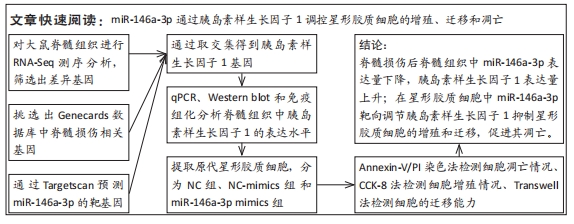

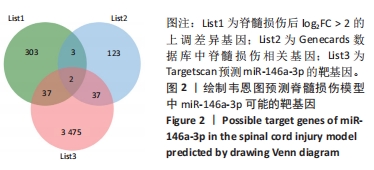
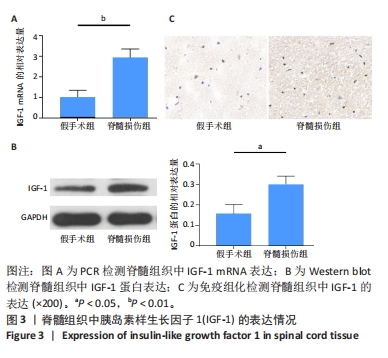
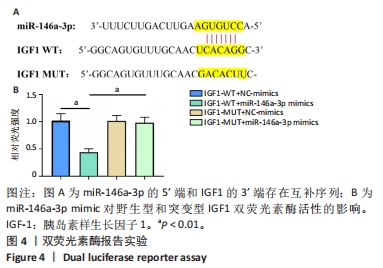
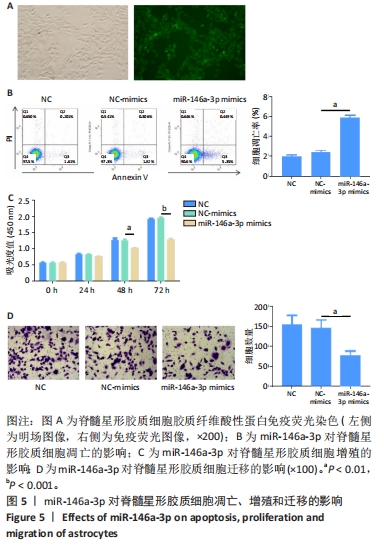
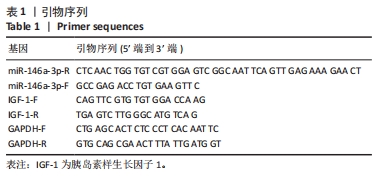
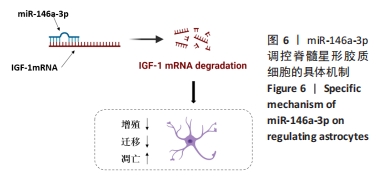 脊髓损伤后,与氧化应激、炎症、自噬和细胞凋亡等继发性损伤相关的非编码RNAs出现显著差异表达,导致靶基因表达差异和细胞功能发生变化。星形胶质细胞中的miR-146a-3p参与许多神经系统疾病的发生发展,然而其对星形胶质细胞的具体作用尚未明确。此次实验研究miR-146a-3p在脊髓损伤中的具体作用及其相关机制,qPCR结果提示脊髓损伤后脊髓组织中的miR-146a-3p表达量降低,通过RNA-Seq测序、生物信息学方法发现纤溶酶原激活物抑制因子1(plasminogen activator inhibitor 1/serpin family E member 1,Serpine1)和IGF-1可能是miR-146a-3p调控的靶基因。目前鲜有研究报道Serpine1与脊髓损伤和脊髓星形胶质细胞的关系,而IGF-1对脊髓损伤和脊髓星形胶质细胞的功能有重要的影响。
脊髓损伤后,与氧化应激、炎症、自噬和细胞凋亡等继发性损伤相关的非编码RNAs出现显著差异表达,导致靶基因表达差异和细胞功能发生变化。星形胶质细胞中的miR-146a-3p参与许多神经系统疾病的发生发展,然而其对星形胶质细胞的具体作用尚未明确。此次实验研究miR-146a-3p在脊髓损伤中的具体作用及其相关机制,qPCR结果提示脊髓损伤后脊髓组织中的miR-146a-3p表达量降低,通过RNA-Seq测序、生物信息学方法发现纤溶酶原激活物抑制因子1(plasminogen activator inhibitor 1/serpin family E member 1,Serpine1)和IGF-1可能是miR-146a-3p调控的靶基因。目前鲜有研究报道Serpine1与脊髓损伤和脊髓星形胶质细胞的关系,而IGF-1对脊髓损伤和脊髓星形胶质细胞的功能有重要的影响。